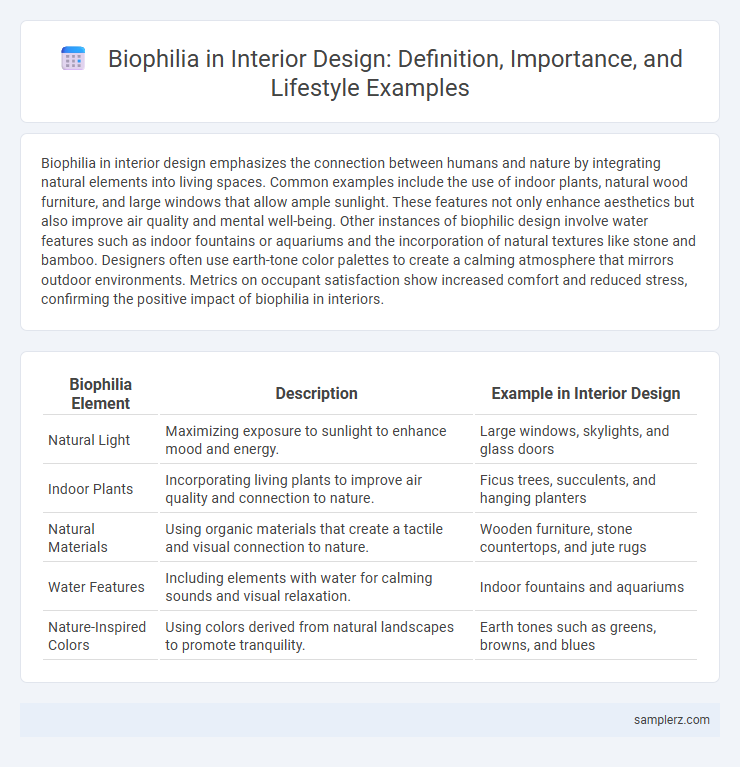Biophilia in interior design emphasizes the connection between humans and nature by integrating natural elements into living spaces. Common examples include the use of indoor plants, natural wood furniture, and large windows that allow ample sunlight. These features not only enhance aesthetics but also improve air quality and mental well-being. Other instances of biophilic design involve water features such as indoor fountains or aquariums and the incorporation of natural textures like stone and bamboo. Designers often use earth-tone color palettes to create a calming atmosphere that mirrors outdoor environments. Metrics on occupant satisfaction show increased comfort and reduced stress, confirming the positive impact of biophilia in interiors.
Table of Comparison
| Biophilia Element | Description | Example in Interior Design |
|---|---|---|
| Natural Light | Maximizing exposure to sunlight to enhance mood and energy. | Large windows, skylights, and glass doors |
| Indoor Plants | Incorporating living plants to improve air quality and connection to nature. | Ficus trees, succulents, and hanging planters |
| Natural Materials | Using organic materials that create a tactile and visual connection to nature. | Wooden furniture, stone countertops, and jute rugs |
| Water Features | Including elements with water for calming sounds and visual relaxation. | Indoor fountains and aquariums |
| Nature-Inspired Colors | Using colors derived from natural landscapes to promote tranquility. | Earth tones such as greens, browns, and blues |
Integrating Indoor Plants for Natural Ambiance
Integrating indoor plants such as fiddle leaf figs, snake plants, and pothos enhances biophilia by creating a natural ambiance that promotes relaxation and improves air quality. Strategically placing greenery near windows or using hanging planters maximizes sunlight exposure and visual connectivity with nature. Incorporating a variety of textures and leaf shapes boosts aesthetic appeal and supports a holistic wellness environment.
Maximizing Natural Light in Living Spaces
Maximizing natural light in living spaces enhances biophilic design by creating a direct connection to nature, promoting well-being and reducing energy consumption. Large windows, skylights, and open floor plans allow sunlight to penetrate deeper into interiors, highlighting organic materials and natural textures. Incorporating reflective surfaces like mirrors and light-colored walls further amplifies daylight, fostering a bright and harmonious living environment.
Living Green Walls: Bringing Nature Indoors
Living green walls integrate vibrant plant life into interior spaces, enhancing air quality and reducing stress levels. These vertical gardens not only maximize limited floor space but also promote psychological well-being through natural aesthetics. Incorporating species like ferns, pothos, and succulents creates dynamic, low-maintenance ecosystems that transform living areas into serene, health-boosting environments.
Using Organic Materials in Home Design
Using organic materials like reclaimed wood, bamboo, and natural fibers in home design enhances biophilic interiors by fostering a strong connection to nature. These sustainable materials not only improve indoor air quality but also add warmth and texture, creating a calming and inviting atmosphere. Incorporating elements such as live-edge wooden furniture and jute rugs supports eco-friendly living while promoting well-being through sensory engagement with natural surfaces.
Creating Tranquil Water Features at Home
Incorporating tranquil water features such as indoor fountains or small cascading waterfalls enhances biophilia in interior design by mimicking natural water elements that promote relaxation and reduce stress. These water installations improve air quality and introduce soothing sounds, fostering a calming atmosphere ideal for meditation or mindfulness practices. Using materials like natural stone and integrating aquatic plants further deepens the connection to nature, enriching the sensory experience within home environments.
Nature-Inspired Color Schemes and Textures
Nature-inspired color schemes in interior design incorporate earthy tones such as moss green, terracotta, and sandy beige to evoke a sense of tranquility and connection to the outdoors. Textures like natural wood grain, stone surfaces, and woven fibers enhance the biophilic experience by adding tactile depth that mimics natural environments. Incorporating these elements promotes well-being and creates harmonious living spaces that reflect the organic beauty of nature.
Enhancing Wellbeing with Natural Scents
Incorporating biophilic design through natural scents like lavender, cedarwood, and eucalyptus enhances wellbeing by reducing stress and promoting relaxation within interior spaces. These aromatic elements connect occupants to nature, improving mood and cognitive function. Diffusing essential oils or using scented candles creates a sensory-rich environment that supports mental clarity and emotional balance.
Open Floor Plans for Seamless Outdoor Connection
Open floor plans are a prime example of biophilia in interior design, creating a seamless connection between indoor and outdoor spaces by incorporating large windows, sliding glass doors, and minimal barriers. This design enhances natural light flow, improves ventilation, and fosters a sense of openness that integrates nature into everyday living areas. By merging living rooms, kitchens, and patios, open floor plans encourage interaction with the surrounding environment, promoting well-being and a deeper connection to nature.
Sustainable Furniture Choices for Biophilic Design
Sustainable furniture choices for biophilic design prioritize natural materials like reclaimed wood, bamboo, and organic cotton, enhancing indoor environmental quality while reducing ecological impact. Incorporating non-toxic finishes and certifications such as FSC or GREENGUARD ensures healthier living spaces and supports responsible forest management. These eco-friendly pieces not only foster a closer connection to nature but also contribute to long-term sustainability in interior design.
Indoor Gardens and Urban Jungle Concepts
Indoor gardens and urban jungle concepts transform living spaces by integrating lush greenery that enhances air quality and mental well-being. Incorporating a variety of plants such as ferns, succulents, and tropical species creates a natural oasis that supports biophilic design principles. Strategic placement of vertical gardens, hanging planters, and terrariums maximizes space while fostering a deep connection to nature within urban environments.

example of biophilia in interior Infographic
 samplerz.com
samplerz.com